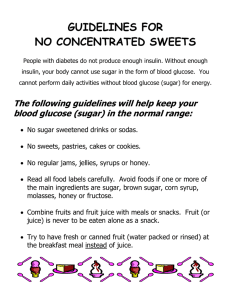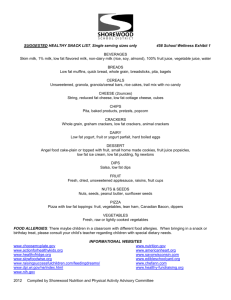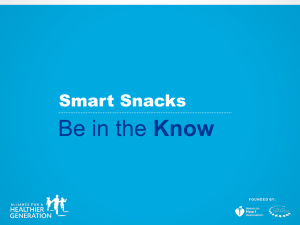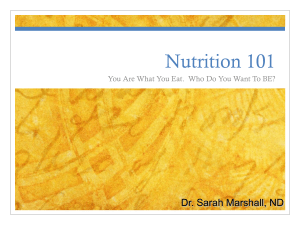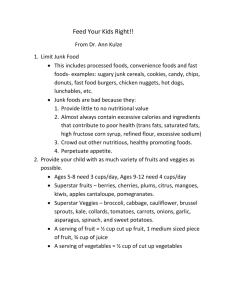Reading food labels The Food Commission Guide to
advertisement
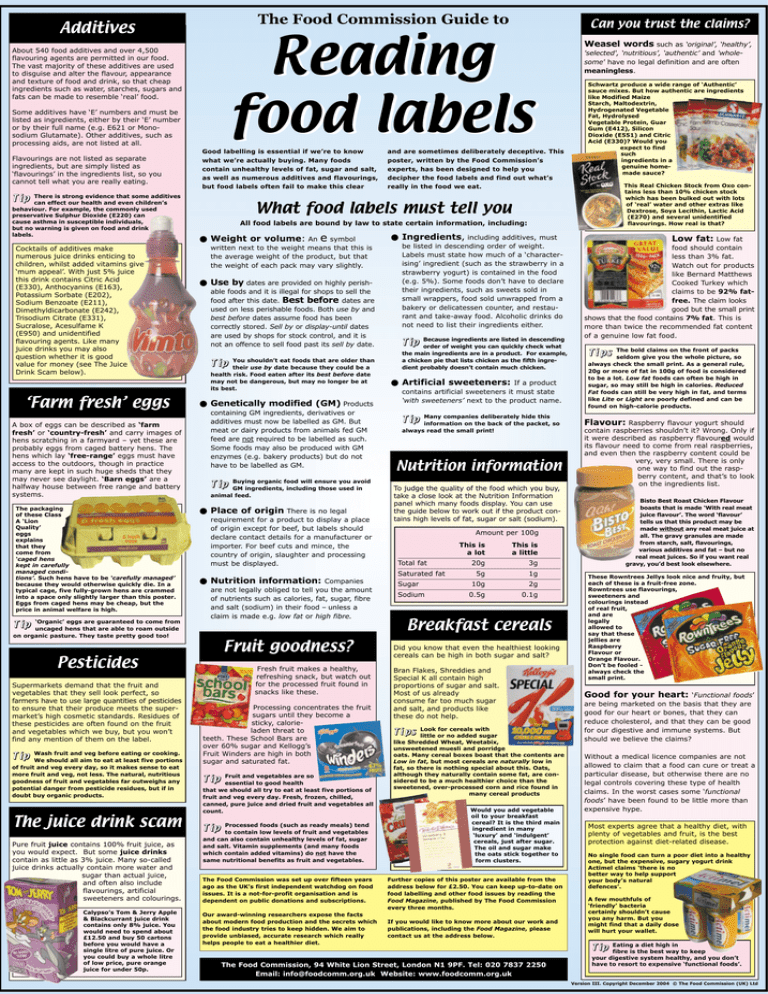
The Food Commission Guide to Additives Reading food labels About 540 food additives and over 4,500 flavouring agents are permitted in our food. The vast majority of these additives are used to disguise and alter the flavour, appearance and texture of food and drink, so that cheap ingredients such as water, starches, sugars and fats can be made to resemble ‘real’ food. Some additives have ‘E’ numbers and must be listed as ingredients, either by their ‘E’ number or by their full name (e.g. E621 or Monosodium Glutamate). Other additives, such as processing aids, are not listed at all. Flavourings are not listed as separate ingredients, but are simply listed as ‘flavourings’ in the ingredients list, so you cannot tell what you are really eating. There is strong evidence that some additives can effect our health and even children’s behaviour. For example, the commonly used preservative Sulphur Dioxide (E220) can cause asthma in susceptible individuals, but no warning is given on food and drink labels. Good labelling is essential if we’re to know what we’re actually buying. Many foods contain unhealthy levels of fat, sugar and salt, as well as numerous additives and flavourings, but food labels often fail to make this clear T ip Cocktails of additives make numerous juice drinks enticing to children, whilst added vitamins give ‘mum appeal’. With just 5% juice this drink contains Citric Acid (E330), Anthocyanins (E163), Potassium Sorbate (E202), Sodium Benzoate (E211), Dimethyldicarbonate (E242), Trisodium Citrate (E331), Sucralose, Acesulfame K (E950) and unidentified flavouring agents. Like many juice drinks you may also question whether it is good value for money (see The Juice Drink Scam below). ‘Farm fresh’ eggs A box of eggs can be described as ‘farm fresh’ or ‘country-fresh’ and carry images of hens scratching in a farmyard – yet these are probably eggs from caged battery hens. The hens which lay ‘free-range’ eggs must have access to the outdoors, though in practice many are kept in such huge sheds that they may never see daylight. ‘Barn eggs’ are a halfway house between free range and battery systems. The packaging of these Class A ‘Lion Quality’ eggs explains that they come from ‘caged hens kept in carefully managed conditions’. Such hens have to be ‘carefully managed’ because they would otherwise quickly die. In a typical cage, five fully-grown hens are crammed into a space only slightly larger than this poster. Eggs from caged hens may be cheap, but the price in animal welfare is high. ‘Organic’ eggs are guaranteed to come from uncaged hens that are able to roam outside on organic pasture. They taste pretty good too! ● Weight or volume: e An symbol written next to the weight means that this is the average weight of the product, but that the weight of each pack may vary slightly. ● Use by dates are provided on highly perishable foods and it is illegal for shops to sell the food after this date. Best before dates are used on less perishable foods. Both use by and best before dates assume food has been correctly stored. Sell by or display-until dates are used by shops for stock control, and it is not an offence to sell food past its sell by date. You shouldn’t eat foods that are older than their use by date because they could be a health risk. Food eaten after its best before date may not be dangerous, but may no longer be at its best. T ip ● Genetically modified (GM) Products containing GM ingredients, derivatives or additives must now be labelled as GM. But meat or dairy products from animals fed GM feed are not required to be labelled as such. Some foods may also be produced with GM enzymes (e.g. bakery products) but do not have to be labelled as GM. Buying organic food will ensure you avoid GM ingredients, including those used in animal feed. T ip ● Place of origin There is no legal requirement for a product to display a place of origin except for beef, but labels should declare contact details for a manufacturer or importer. For beef cuts and mince, the country of origin, slaughter and processing must be displayed. ● Nutrition information: Companies are not legally obliged to tell you the amount of nutrients such as calories, fat, sugar, fibre and salt (sodium) in their food – unless a claim is made e.g. low fat or high fibre. Pesticides Wash fruit and veg before eating or cooking. We should all aim to eat at least five portions of fruit and veg every day, so it makes sense to eat more fruit and veg, not less. The natural, nutritious goodness of fruit and vegetables far outweighs any potential danger from pesticide residues, but if in doubt buy organic products. The juice drink scam Pure fruit juice contains 100% fruit juice, as you would expect. But some juice drinks contain as little as 3% juice. Many so-called juice drinks actually contain more water and sugar than actual juice, and often also include flavourings, artificial sweeteners and colourings. Calypso’s Tom & Jerry Apple & Blackcurrant juice drink contains only 8% juice. You would need to spend about £12.50 and buy 50 cartons before you would have a single litre of pure juice. Or you could buy a whole litre of low price, pure orange juice for under 50p. 'selected', ‘nutritious’, ‘authentic’ and 'wholesome' have no legal definition and are often meaningless. Schwartz produce a wide range of ‘Authentic’ sauce mixes. But how authentic are ingredients like Modified Maize Starch, Maltodextrin, Hydrogenated Vegetable Fat, Hydrolysed Vegetable Protein, Guar Gum (E412), Silicon Dioxide (E551) and Citric Acid (E330)? Would you expect to find such ingredients in a genuine homemade sauce? This Real Chicken Stock from Oxo contains less than 10% chicken stock which has been bulked out with lots of ‘real’ water and other extras like Dextrose, Soya Lecithin, Lactic Acid (E270) and several unidentified flavourings. How real is that? All food labels are bound by law to state certain information, including: Fruit goodness? T ip and are sometimes deliberately deceptive. This poster, written by the Food Commission’s experts, has been designed to help you decipher the food labels and find out what’s really in the food we eat. Weasel words such as ‘original’, ‘healthy’, What food labels must tell you T ip Supermarkets demand that the fruit and vegetables that they sell look perfect, so farmers have to use large quantities of pesticides to ensure that their produce meets the supermarket’s high cosmetic standards. Residues of these pesticides are often found on the fruit and vegetables which we buy, but you won’t find any mention of them on the label. Can you trust the claims? Fresh fruit makes a healthy, refreshing snack, but watch out for the processed fruit found in snacks like these. Processing concentrates the fruit sugars until they become a sticky, calorieladen threat to teeth. These School Bars are over 60% sugar and Kellogg’s Fruit Winders are high in both sugar and saturated fat. Fruit and vegetables are so essential to good health that we should all try to eat at least five portions of fruit and veg every day. Fresh, frozen, chilled, canned, pure juice and dried fruit and vegetables all count. T ip Processed foods (such as ready meals) tend to contain low levels of fruit and vegetables and can also contain unhealthy levels of fat, sugar and salt. Vitamin supplements (and many foods which contain added vitamins) do not have the same nutritional benefits as fruit and vegetables. T ip The Food Commission was set up over fifteen years ago as the UK’s first independent watchdog on food issues. It is a not-for-profit organisation and is dependent on public donations and subscriptions. Our award-winning researchers expose the facts about modern food production and the secrets which the food industry tries to keep hidden. We aim to provide unbiased, accurate research which really helps people to eat a healthier diet. ● Ingredients, including additives, must be listed in descending order of weight. Labels must state how much of a ‘characterising’ ingredient (such as the strawberry in a strawberry yogurt) is contained in the food (e.g. 5%). Some foods don’t have to declare their ingredients, such as sweets sold in small wrappers, food sold unwrapped from a bakery or delicatessen counter, and restaurant and take-away food. Alcoholic drinks do not need to list their ingredients either. Because ingredients are listed in descending order of weight you can quickly check what the main ingredients are in a product. For example, a chicken pie that lists chicken as the fifth ingredient probably doesn’t contain much chicken. T ip ● Artificial sweeteners: If a product contains artificial sweeteners it must state ‘with sweeteners’ next to the product name. Many companies deliberately hide this information on the back of the packet, so always read the small print! T ip Nutrition information To judge the quality of the food which you buy, take a close look at the Nutrition Information panel which many foods display. You can use the guide below to work out if the product contains high levels of fat, sugar or salt (sodium). Low fat: Low fat food should contain less than 3% fat. Watch out for products like Bernard Matthews Cooked Turkey which claims to be 92% fatfree. The claim looks good but the small print shows that the food contains 7% fat. This is more than twice the recommended fat content of a genuine low fat food. The bold claims on the front of packs seldom give you the whole picture, so always check the small print. As a general rule, 20g or more of fat in 100g of food is considered to be a lot. Low fat foods can often be high in sugar, so may still be high in calories. Reduced Fat foods can still be very high in fat, and terms like Lite or Light are poorly defined and can be found on high-calorie products. T i ps Flavour: Raspberry flavour yogurt should contain raspberries shouldn’t it? Wrong. Only if it were described as raspberry flavoured would its flavour need to come from real raspberries, and even then the raspberry content could be very, very small. There is only one way to find out the raspberry content, and that’s to look on the ingredients list. Bisto Best Roast Chicken Flavour boasts that is made ‘With real meat juice flavour’. The word ‘flavour’ tells us that this product may be made without any real meat juice at all. The gravy granules are made from starch, salt, flavourings, various additives and fat – but no real meat juices. So if you want real gravy, you’d best look elsewhere. Amount per 100g Total fat Saturated fat Sugar Sodium This is a lot This is a little 20g 3g 5g 1g 10g 2g 0.5g 0.1g Breakfast cereals Did you know that even the healthiest looking cereals can be high in both sugar and salt? Bran Flakes, Shreddies and Special K all contain high proportions of sugar and salt. Most of us already consume far too much sugar and salt, and products like these do not help. Look for cereals with little or no added sugar like Shredded Wheat, Weetabix, unsweetened muesli and porridge oats. Many cereal boxes boast that the contents are Low in fat, but most cereals are naturally low in fat, so there is nothing special about this. Oats, although they naturally contain some fat, are considered to be a much healthier choice than the sweetened, over-processed corn and rice found in many cereal products T i ps Would you add vegetable oil to your breakfast cereal? It is the third main ingredient in many ‘luxury’ and ‘indulgent’ cereals, just after sugar. The oil and sugar make the oats stick together to form clusters. Further copies of this poster are available from the address below for £2.50. You can keep up-to-date on food labelling and other food issues by reading the Food Magazine, published by The Food Commission every three months. If you would like to know more about our work and publications, including the Food Magazine, please contact us at the address below. The Food Commission, 94 White Lion Street, London N1 9PF. Tel: 020 7837 2250 Email: info@foodcomm.org.uk Website: www.foodcomm.org.uk These Rowntrees Jellys look nice and fruity, but each of these is a fruit-free zone. Rowntrees use flavourings, sweeteners and colourings instead of real fruit, and are legally allowed to say that these jellies are Raspberry Flavour or Orange Flavour. Don’t be fooled always check the small print. Good for your heart: ‘Functional foods’ are being marketed on the basis that they are good for our heart or bones, that they can reduce cholesterol, and that they can be good for our digestive and immune systems. But should we believe the claims? Without a medical licence companies are not allowed to claim that a food can cure or treat a particular disease, but otherwise there are no legal controls covering these type of health claims. In the worst cases some ‘functional foods’ have been found to be little more than expensive hype. Most experts agree that a healthy diet, with plenty of vegetables and fruit, is the best protection against diet-related disease. No single food can turn a poor diet into a healthy one, but the expensive, sugary yogurt drink Actimel claims ‘there is no better way to help support your body’s natural defences’. A few mouthfuls of ‘friendly’ bacteria certainly shouldn’t cause you any harm. But you might find that a daily dose will hurt your wallet. Eating a diet high in fibre is the best way to keep your digestive system healthy, and you don’t have to resort to expensive ‘functional foods’. T ip Version III. Copyright December 2004 © The Food Commission (UK) Ltd

